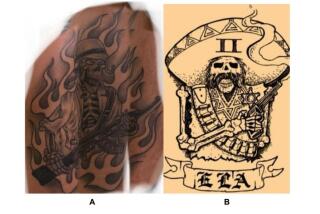L.A. County deputy alleges ‘Executioner’ gang dominates Compton sheriff station
- Share via
Days after Austreberto Gonzalez anonymously reported a fellow Los Angeles County sheriff’s deputy to internal affairs for assaulting a colleague behind the parking lot of the Compton station, a text popped up on his phone.
It was a photo of graffiti scrawled on a dial pad at the station’s parking lot entrance: “ART IS A RAT,” it read.
It was one of the first instances of retaliation that continued for months, exacted by the Executioners, a band of deputies with matching tattoos that wields vast power at the Compton station, he alleged in a claim filed against Los Angeles County. The claim says the group — sporting tattoos of a skull with Nazi imagery and an AK-47 — celebrates deputy shootings and the induction of new members with “inking parties.”
In recent years, the claim says, its members were involved in setting illegal arrest quotas and threatening work slowdowns — which involve ignoring or responding slowly to calls — when they did not get preferred assignments.
The allegations have revived long-standing concerns that inked deputy groups — with monikers such as the Spartans, Regulators, Grim Reapers and Banditos — operate out of several Sheriff’s Department stations and represent what many in the community see as criminal gangs within law enforcement. The existence of such fraternities has sparked multiple internal investigations and recently a federal probe by the FBI, but the groups have remained entrenched, with many civil liberties advocates accusing the Sheriff’s Department of turning a blind eye.
“We have a gang here that has grown to the point where it dominates every aspect of life at the Compton station,” said Alan Romero, an attorney representing Gonzalez in the claim, which is a precursor to a lawsuit. “It essentially controls scheduling, the distribution of informant tips, and assignments to deputies in the station with preference shown to members of the gang as well as prospects.”
Sheriff Alex Villanueva said during a live Facebook broadcast Wednesday that “there is no gang of any deputies running any station.” But he said that he was disturbed by the allegations in the claim and that “swift administrative action” is being taken.
Secret societies of Los Angeles County sheriff’s deputies with matching skeleton tattoos have long been a liability in cases in which inked deputies are accused of excessive force and harassment.
In a statement later, Villanueva said he ordered an investigation.
“I take these allegations very seriously and recently enacted a policy specifically addressing illicit groups, deputy cliques, and subgroups,” he said, referring to measures he enacted in February that prohibit deputies from participating in cliques.
Inspector General Max Huntsman said Thursday that he is “aware of no implementation whatsoever” of the policy and that his office can’t effectively investigate the secret societies “because of the obstruction of the Sheriff’s Department.” He said the criminal investigation of Banditos members who were allegedly involved in an off-duty beating in 2018 amounted to a “cover-up,” noting that more than 20 deputies were not required to give statements.
Gonzalez’s claim alleges the Compton station clique numbers about 20 deputies, while 20 more are prospects or associates. Many work at night, the claim says, and communicate through WhatsApp. Black and female deputies are not allowed in the clique, the claim says.
“Nearly all the CPT Deputies who have been involved in high-profile shootings and out-of-policy beatings at CPT in recent years have been ‘inked’ members of The Executioners,” the claim alleges. “‘Inking’ refers to the act of each newly made member of The Executioners receiving a matching tattoo indicating membership in the organization. … Members become inked as ‘Executioners’ after executing members of the public, or otherwise committing acts of violence in furtherance of the gang.”
Retaliation against Gonzalez, the claim states, forced him to step down from his field training officer position. Deputies refused to partner with him, while an inked deputy in dispatch saddled him with calls.
For decades, a subculture of matching tattoos has been rooted in the Sheriff’s Department, where secret societies have been accused of glorifying an aggressive style of policing. Sean Kennedy, member of the Civilian Oversight Commission and professor at Loyola Law School, said Thursday that he and his students have identified at least 17 gangs — some of them historical — in the department.
Defenders of the groups say they represent hard work and boost morale by fostering camaraderie.
The FBI, however, has been interviewing deputies over the last year about whether clique members are actively violating civil rights of the public with false reports or violence. Rand Corp., a nonprofit research agency, has also been studying the clique culture and plans to publish its report in January.
The new allegations out of Compton come as the station faces extra scrutiny recently in a number of high-profile uses of force, including the arrest and beating in May of Dalvin Price, who was pinned to the ground and struck by three deputies at Rosecrans and Santa Fe avenues, and the fatal shooting last month in Gardena of Andres Guardado, an 18-year-old who was shot by a deputy five times in the back.
Details about the Compton clique were first revealed in a civil case brought by the family of Donta Taylor, a 31-year-old man who was shot and killed when deputies opened fire during a foot chase in 2016. Deputies claimed Taylor had a handgun, but no weapon was found.
One of the deputies, Samuel Aldama, admitted under oath to having ink on his calf depicting a skull with a rifle and a military-style helmet surrounded by flames, along with the letters “CPT” for Compton. Romero alleges that the same image was found on a mouse pad and pencil holder at the station desk of someone belonging to the Executioners.
The Taylor family lawsuit was settled for $7 million last year.
The revelations were disturbing to observers who watched the department try to implement reforms following a jail abuse and corruption scandal that ultimately led to the convictions of several high-ranking officials including former Sheriff Lee Baca and his undersheriff, Paul Tanaka, who was a tattooed member of the Vikings.
A top jail official had described exclusive gangs of deputies in Men’s Central Jail who would “earn their ink” by breaking inmates’ bones.
According to Gonzalez’s claim, he and two other deputies complained in 2017 that they were being improperly punished with undesirable assignments for not meeting illegal quotas and were told by a sergeant, “Yes, you should have known that by now,” according to the claim.
Illegal quotas resulted in deputies more than doubling their arrest numbers each month, which meant the “violation of the civil rights” of hundreds of residents, the claim states.
“This is an atomic bomb that has been dropped on law enforcement,” John Sweeney, an attorney who represented Taylor’s family, said of Gonzalez’s claim.
Sweeney’s firm brought another excessive-force case involving the same deputies in the Taylor case, which is pending in federal court. The county has denied allegations that the deputies beat the plaintiff, Sheldon Lockett, or used racial slurs against him during the incident in 2016.
Now, Lockett’s attorneys are citing Gonzalez’s claim in a court filing seeking to reopen discovery, depose several deputies again and examine their WhatsApp accounts.
Compton has long had a troubled history with law enforcement. In 2000, the city disbanded its police force after struggling to contain rising crime and gang violence.
The solution, as city leaders saw it, was to hire the Sheriff’s Department to patrol the streets, a move advertised as a way to have more sophisticated policing that would save the city $7 million a year out of its $20-million budget for policing costs. Proponents claimed the money would be reinvested in the community and would lead to an economic revival.
But sheriff’s deputies in Compton were increasingly seen as outsiders and developed a reputation among some locals for aggressive tactics. Deputies were heavily criticized in 2005 after firing about 120 rounds at a moving vehicle driven by an unarmed man, who was shot four times. In 2009, a 16-year-old boy was fatally shot in the back by a Compton station deputy, who claimed the boy pointed a gun at him. An attorney for the boy’s family suggested the deputy planted the weapon.
More to Read
Sign up for Essential California
The most important California stories and recommendations in your inbox every morning.
You may occasionally receive promotional content from the Los Angeles Times.











